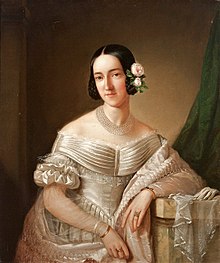Hermine Amelie Marie of Austria
Hermine Amelie Marie of Austria (born September 14, 1817 in Ofen , Kingdom of Hungary , † February 13, 1842 in Vienna , Austrian Empire ) was a daughter of Archduke Joseph and his second wife, Princess Hermine of Anhalt-Bernburg-Schaumburg-Hoym . She belonged to the Hungarian branch of the House of Habsburg-Lothringen and was a granddaughter of Emperor Leopold II on her father's side .
Life
Hermine was the twin sister of Archduke Stefan Franz Viktor of Austria and her father's favorite daughter. The twins were seven-month-olds , the mother died on the same day as a result of the difficult birth. The girl and her twin brother were raised by the third wife of the Palatine Joseph, Maria Dorothea von Württemberg . According to contemporary reports, the girl was cheerful and likeable and was "idolized" by her father, the Palatine. From him she also learned the Hungarian language . In 1834, at the age of 14, Hermione was appointed star cross lady .
On September 16, 1839 she was appointed abbess of the Imperial and Royal Theresian noble women's monastery at Prague Castle ( Hradschin ). She was never married and devoted her entire life to charity, probably also because she had to struggle with serious health problems throughout her life.
Archduchess Hermine died unexpectedly on February 13, 1842 in Vienna. It was a major loss for the Palatine. He arranged for the corpse to be transferred to Ofen and ordered a 6-week court mourning. He was buried on February 21, 1842 in the Palatinus Crypt on Burgberg in Ofen. Since there was no permanent bridge over the Danube at that time, a large number of visitors who wanted to take part in the burial came across the frozen Danube from Pest.
souvenir
Since Archduchess Hermine was extremely popular in Hungary, the representatives of the city of Pest decided to erect a permanent monument to her. Four wealthy citizens of Pest, the music publisher Ferdinand Tomala, the cabinet maker Ferenc Steindl, the upholsterer Karoly Coffin and the engraver Heinrich Wahlkampf, applied to the Palatine on February 28, 1842, asking for permission to build a memorial chapel for the Archduchess to build. Permission was given by the Palatine Joseph.
A building site in today's XIV. Budapest district ( Zugló, the old German name was Lerchenfeld ) was selected, where a chapel was to be built according to the plans of the Hungarian architect József Hild . Construction work on a neo-Gothic chapel with a turret began in 1843. However, the construction work could not be completed until 1855. The chapel was solemnly consecrated on the day of the birth of Mary , September 8, 1856, by the Archbishop of Gran and Prince Primate of Hungary, Cardinal János Scitovszky . The musical organization of the celebration was up to Franz Liszt .
The district in which the Herminen Chapel is located was also renamed Herminenfeld (Hungarian Herminamezõ ) in honor of the Archduchess . He kept this name within the XIV. Parish until today.
literature

- Brigitte Hamann : The Habsburgs. A biographical lexicon. Ueberreuter, Vienna 1988, ISBN 3-492-03163-3 .
- Ildikó Hankó - István Kiszely: A nádori Kripta , Budapest 1990, ISBN 963-7805-54-0 (Hungarian)
- Budapest Lexicon, 2 volumes, Budapest 1993, ISBN 963-05-6409-2 (Hungarian)
Individual evidence
- ↑ In the 1980s, the Hungarian anthropologist István Kiszely examined the embalmed corpse of the Archduchess in the Palatine Crypt on the castle hill of Ofen. It turned out that Hermione had had serious health problems all her life. On the basis of radiological examinations, he found that she suffered from a severe curvature of the spine ( lat . Juvenis kyphoscoliosis maioris gradus ), which caused a deformity of the chest. (Ildikó Hankó - István Kiszely: A nádori Kripta , Budapest 1990, p. 95)
- ↑ Ildikó Hankó - István Kiszely: A Nádori Kripta , Budapest 1990, p 93
- ^ Budapest Lexikon , Vol. 1, p. 551
| personal data | |
|---|---|
| SURNAME | Hermine Amelie Marie of Austria |
| BRIEF DESCRIPTION | Austrian noblewoman and abbess |
| DATE OF BIRTH | September 14, 1817 |
| PLACE OF BIRTH | Furnace , Kingdom of Hungary |
| DATE OF DEATH | February 13, 1842 |
| Place of death | Vienna , Austrian Empire |

